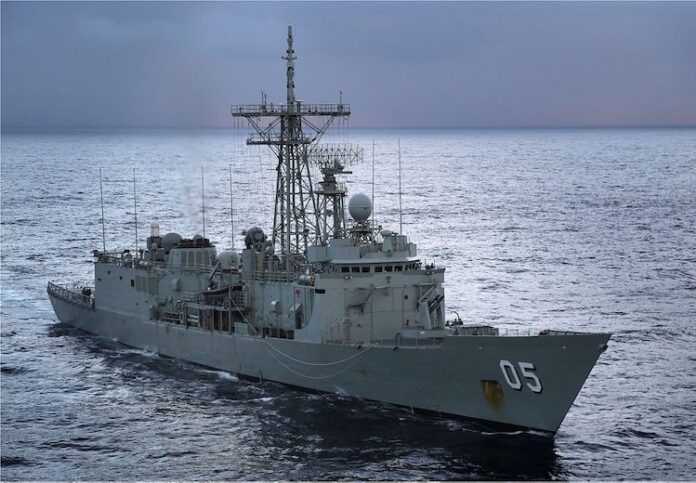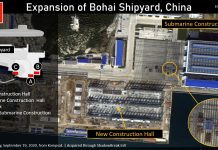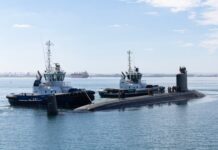
The Journal of the Australian Naval Institute offered a forum where its members could propose suggestions to improve the RAN. Short pieces were often published in the ‘Illumination Rounds’ section. Unlike today, it was common for serving officers to publicly comment on changes that think should be made to their Navy. In this April 1999 example, Commander (later Vice Admiral) Peter Jones, who was then commanding the frigate HMAS Melbourne undertaking an Operation Damask deployment to the Arabian Gulf, wrote a piece on the need for greater ship design standardisation. It makes for interesting reading, as today the RAN still has one of the most heterogeneous fleets in the world.
The Need for a Ship Design Philosophy for the RAN
In recent years the RAN has had to wrestle with a broad array of problems related to our ships. Examples are the LPAs (Kanimbla and Manoora), the Collins Class and Westralia. Overarching these problems has been a shortage of trained personnel as well as fiscal constraints which impact on ship repair and stores support. The absence of and adherence to a ship design philosophy has had either a direct or indirect impact on all these issues.
With the outlook for even more budget tightening, not to mention growing public and government impatience with perceived Defence and/or Navy mishandling of projects, there is a compelling argument to adopt such a philosophy.
So what is a design philosophy? It is a set of standards and criteria that form the framework for design specifications. In our case the criteria should encompass elements such as desired seakeeping, endurance, habitability standards, redundancy, levels of technology and associated risk for different systems, local content requirements, high power standards, MILSPEC criteria (which systems should be MILSPEC and which COTS), signature features and equipment commonality.
The design philosophy criteria would apply, where relevant, through the entire Fleet. Such a philosophy must be dynamic, reflecting technological advances. But it also builds-on the successes and failures of previous designs. A design philosophy by its very nature encourages two things – equipment and training commonality, and reduction in project risk. These are two areas of course that have been difficult for the RAN to tackle. Unfortunately, the unsophistication of our acquisition process has meant the real dollar value of commonality through the Fleet has not been captured or appreciated. Despite this it can be appreciated that when money is tight, it is a luxury for the RAN to support logistically and in training over twenty diesel generator types and around a dozen different navigation radars in the Fleet.
In contrast to the RAN the benefit of an evolutionary design philosophy is consciously or not demonstrated by most advanced navies in the world. A glance at any of the first league navies in Janes or Combat Fleets will reveal a lineage in design that focuses on qualitative improvements in ships.
A good example of the benefits of a design philosophy is the German Navy’s frigate force. The F122 Class frigate is the baseline for two subsequent designs. The F123 Class ASW frigate while having a slightly different hull form and introducing the MEKO concept retains the same machinery plant and many other systems. The latest F124 Class AAW frigate has the F123’s hull with once again many common systems. It does not take much imagination to work out the savings both in stores and training. The other advantage of this approach is that it reduces the number of untried systems in each new ship.
In contrast to navies with a tradition of local design and construction, the RAN has shifted from a RN derived fleet, then to a short lived attempt at an indigenous design fleet (the DDL, Stalwart, Cook and AOR Protector) to now a mix of Australian, US, Italian, German, French and Swedish designs. Each of these designs comes with their own distinct design philosophy. The RAN approach often has been driven for the desire for an “existing proven design” to reduce risk. In practice, however, this has often translated into a foreign design modified to a point where there is little corporate knowledge to be gained from other ships in service around the world. The end result is a Fleet that is a heterogenous mix of old and new that is hard to build, expensive to modify to our purpose and difficult to support.
Yet even with our existing assortment it is still possible to insist on some uniformity. Look at our frigate force for example. The FFGs have proved excellent ships. They are economical, seaworthy, well armed and possess good damage control for their time of build. They also have reasonably good habitability and are well laid out for replenishment. Even if we did not want to build on the same hull, the RAN should have taken the good points of the FFGs and improved upon them in the ANZAC. Alas this was not the case and the lack of commonality in damage control markings is a basic example.
If there is doubt about the value of a design philosophy it is worth taking a historical perspective. For the RAN there is a long term legacy resulting from an absence of a design philosophy as well as a lack of commitment to local design. Since World War II the RAN’s force structure has been truncated due to rising costs in local ship construction. A central factor here has been the stop-start nature of ship building.
Shipyards were never going to become efficient when there was no prospect of further work beyond that on the slips at the time. The ‘slow hammer’ syndrome. A steady program based on lower risk evolutionary designs would have in large part overcome this problem. For the RAN the result was that a fifth Q Class frigate modernisation, a fourth Daring, Protector and a second Success (hence Westralia) never materialised. It was also a factor in the delay and reduction in scope of the Daring, DE and DDG modernisations. As can be seen the RAN has paid dearly for a short term approach to acquisition.
As can be seen the advantages of a design philosophy are many. What needs to be done to realise the operational and fiscal benefits of a coherent design philosophy. First we need to look at our Fleet. Identify the characteristics we like and dislike and what we want future designs to possess. Then settle on some standard ship systems. Such an initiative has to be seen as a long term project. It may not lead to the most technologically advanced ships in every area but it will lead to more reliable ships with lower risk acquisition and a more manageable logistic and training requirement.
Many would say the adoption of a design philosophy is just the application of commonsense. It is. But it requires a change in thinking in acquisition and a will to see the reform through. For those who say it is too difficult one has only to see other navies managing to achieve it. Finally, if properly implemented, the benefits of a design philosophy would eclipse anything that the current Naval Quality Management, Activity Based Management or the Defence Reform Program could hope to achieve.
About the Author
Vice Admiral Peter Jones AO DSC RAN (retired) joined the ANI in its early years when a cadet-midshipman. He served on its Council on a number of occasions and at different times was its journal editor, vice president and president. In his 40 year naval career, besides Melbourne, he commanded the RAN surface task group, the coalition Maritime Interception Force, was the Maritime Interception Operations Screen Commander during the 2003 Iraq War, Australian Naval Systems Command and Defence’s Capability Development Group.



